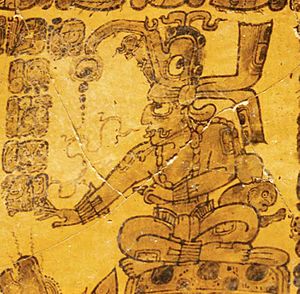Kinich Ahau facts for kids
Kinich Ahau (pronounced K'inich Ajaw) was the name of the Maya sun god. The Maya people lived in what is now Mexico and Central America. When experts study old Maya books called codices, they often refer to him as God G. In ancient Maya art, God G is usually shown as a middle-aged man. He has a strong, hooked nose, big square eyes that sometimes look crossed, and a special filed tooth in his upper jaw. Often, you can see a k'in symbol (which means 'sun' or 'day') on his face, sometimes even in his eyes! Even in the 1900s, the Lacandon people in southern Mexico still told stories about Kinich Ahau.
Contents
What's in a Name?
The name Kinich Ahau comes from the Yucatec and Lacandon languages, which are spoken by Maya groups. The word kʼinich probably means 'sun-eyed'. This word was also used as a royal title for kings during the Classic Period of Maya history.
It's important not to confuse Kinich Ahau with other names like Ah Kʼin. Ah Kʼin in Yucatec means 'someone who works with the day'. Since 'day' and 'sun' are the same word in Yucatec, this term was used for Maya priests who dealt with the calendar and religious ceremonies.
Kinich Ahau in Ancient Times
In the 1500s, during the time of the Yucatec Maya, Kinich Ahau was very important. He was the special god for one of the four years in their 52-year calendar cycle. People would perform war dances to honor him at the start of this year. Some believed that Kinich Ahau was a part of a greater god named Itzamna. There was also a famous sun god in the city of Izamal called Kinich Kakmo, which means 'Fire Parrot'. Stories say he would fly down to earth when the sun was directly overhead to eat offerings.
Sun God in Classic Maya Art
You can often see images of God G (Kinich Ahau) on large stucco masks that decorated Maya pyramids. These masks were huge and impressive! However, compared to gods linked to farming, God G doesn't appear as often in other types of art or in stories. Interestingly, the famous Maya Hero Twins, Hunahpu and Xbalanque, are said to have turned into the Sun and Moon, but they are never shown looking like God G.
The Sun's Journey: Eastern Paradise
The Sun God was linked to a beautiful, watery paradise in the east, where the sun rises. In this paradise, he might appear as a mythical water bird or as a young man paddling a canoe. This kind of art suggests that the Maya had beautiful religious poems, much like the Aztec people had poems about a 'flower paradise'.
Kings and the Sun God
The sun deity was often shown as a king (called an ajaw) sitting on a grand throne. Sometimes, he was shown as a ruler holding a special two-headed 'ceremonial bar'. Maya kings themselves were often seen as being like the sun god. For example, the emblem of an early king of Copan, Yax Kʼukʼ Moʼ, showed the sun god's head inside the beaks of a double bird.
Sometimes, ancient Maya kings who were linked to the sun god were shown coming down from the sky. This suggested that they were becoming gods themselves or living on after death. In the city of Yaxchilan, you can see art where the king is inside a sun symbol, and his wife is inside a moon symbol.
The Sun God in the Calendar
In the Maya writing system, the sun god was connected to several important calendar units. He was the patron of the day unit (called kʼin, meaning 'day' or 'sun'). He was also linked to the month of Yaxkʼin, which means 'dry season', and the number Four.
Sun God's Connections to Other Deities
Many other Maya gods also had large eyes, similar to the sun god. These include God D (Itzamna), Chaac (the rain god), and various Maya jaguar gods. The sun god shared some of his features, like the kʼin symbol, with the 'Jaguar God of the Underworld'. This jaguar god is often called the 'Night Sun' because it was believed to be the form the sun took during its journey through the underworld from west to east. Some experts think that these gods who share features might represent different parts of the sun's daily journey.
Stories and Rituals
Most recent Maya stories about the sun god focus on his childhood and the challenges he faced before he actually became the sun. While there are some images showing the sun being carried through the underworld, there aren't many stories about the mature sun god, except for those told by the Lacandon people.
The southern Lacandon people believe that Kinich Ahau, who is the elder brother of the main god, will one day end the world. They say he will come down from the sky and send his jaguars to eat all of humankind. We don't know much about specific rituals for the sun god, but Kinich Ahau does appear often in the Dresden Codex, an ancient Maya book mostly about religious ceremonies.
See also
 In Spanish: Kinich Ahau para niños
In Spanish: Kinich Ahau para niños


